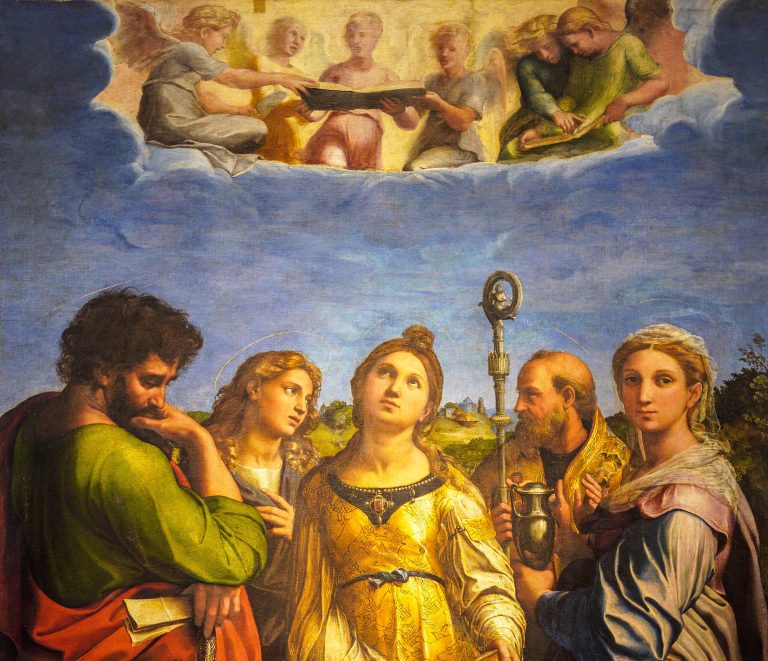St. Cecilia, the patron saint of musicians, is one of the most revered figures in the Christian tradition. Although there is no concrete evidence of her having been a composer or musician herself, her life and martyrdom have inspired centuries of reverence, artistic representations, and music dedicated to her name.
Born into a wealthy Roman family, Cecilia’s story became intertwined with music and divine inspiration through a legendary anecdote. When she was married, it is said that she heard celestial music and “sang in her heart to God.” This connection between music and her unwavering faith led to her veneration as the patron saint of music, linking her name with the divine inspiration of both musicians and composers throughout the ages.
Known as “Cecilia of Rome,” her contributions to Christian tradition, though not as a musician herself, have left a lasting impact on the world of music and art. Her life, particularly the moment of divine inspiration at her wedding, has inspired centuries of artistic and musical creation. She represents the profound connection between faith and art, showing that music can be a path to the divine. Her enduring legacy continues to inspire musicians and artists who seek to express the beauty of the spiritual world in their work.
St. Cecilia’s life and legend

Cecilia was born into a time when Christianity was still a minority religion, and she is believed to have been a devout follower of Christ from a young age. Her family, Roman and likely of high social standing, arranged her marriage to a man named Valerian, who was not a Christian. Legend holds that Cecilia had made a vow of chastity, but out of obedience she agreed to the marriage.
Though the other guests may have heard earthly instruments at her wedding, Cecilia is said to have heard “heavenly music” in her heart, to which she repeated her vow to God. This divine inspiration led to the symbolic association between her and music.
Success
You are now signed up for our newsletter
Success
Check your email to complete sign up
On the night of her wedding, she disclosed her faith and sacred vow to her husband, explaining that an angel watched over her to protect her purity. Skeptical, Valerian wished to see this guardian angel, so she sent him to find the persecuted St. Urban, an aging holy man who instructed and baptized Valerian as Christian.
Upon returning home, Valerian heard heavenly music and saw an angel standing near Cecilia, who held two crowns of roses gathered in Paradise, immortal in their perfection, but only visible to the faithful.
As the angel placed the crowns on Cecilia and Valerian, who knelt before him; he told Valerian, “Because thou hast followed the chaste counsel of thy wife, and hast believed her words, ask what thou wilt, it shall be granted to thee.” Valerian replied, “I have a brother named Tiburtius, whom I love as my own soul; grant that his eyes, also, may be opened to the truth.”
Martyrdom and miracles
Cecilia’s divine inspiration and steadfast devotion to God would ultimately lead to her martyrdom. During a period of Christian persecution in Rome, Valerian and Tiburtius were both martyred for their faith, and Cecilia herself faced intense scrutiny for her role in converting others to Christianity. Refusing to renounce her faith, she was arrested and sentenced to death.
The unusual circumstances surrounding her death add further mystique to the legend. After several failed attempts to kill her in a boiling bath, an executioner was sent to behead her; yet his hand wavered and he left her bleeding from three wounds to the neck and breast.
Full of faith and charity, she spent her final days in prayer and exhortation to her many converts. She had all her possessions distributed to the poor, and asked that her home, where she finally died at the end of three days, be converted to a place of worship.
This consecrated church eventually fell into disrepair, but was rebuilt by Pope Paschal I in the ninth century. While this pious work was in progress, Paschal dreamt that St. Cecilia appeared to him and disclosed the location of her burial. Upon investigation, her body was recovered and deposited in the rebuilt Church of St. Cecilia, in Trastevere, Rome.
Seven centuries later, the tomb was opened in the presence of several dignitaries of the Church, who found her undecayed body lying “on her right side, as one asleep, and in a very modest attitude.” This discovery further cemented her status as a saint, and the church remains a significant pilgrimage site.
St. Cecilia’s legacy and artistic influence
St. Cecilia’s legacy has endured for centuries, especially in the realm of music. Her feast day, celebrated on November 22, has historically been a time for musicians and choirs to offer performances in her honor. During the Renaissance and Baroque periods, she became the subject of numerous works of art and music.
Painters such as Raphael, Rubens, and Artemisia Gentileschi depicted her in their works, often showing her playing musical instruments like the organ or lyre, surrounded by angels. This iconography has contributed to the association of Cecilia with divine inspiration and musical creation.
In addition to visual art, St. Cecilia’s influence has extended to music itself. Composers such as Henry Purcell and Benjamin Britten wrote works dedicated to her. Purcell’s “Hail! Bright Cecilia” (1692) is one of the most famous examples, celebrating the saint as the muse and protector of music. In the 20th century, Britten’s “Hymn to St. Cecilia” (1942) continued this tradition, highlighting her enduring relevance to musicians and composers across the centuries.
Although Cecilia is often associated with music, there is no evidence that she was a musician or a composer; but her life of faith and devotion has become a metaphor for the spiritual source of artistic creation. She represents the idea that music, like all art, can be an expression of the divine, a way to reach God and communicate with the heavens. This has made her a significant figure for Christian musicians and composers throughout history.
Divine inspiration and modern influence
While St. Cecilia lived in a time when Christianity was struggling to gain a foothold in the Roman Empire, her story of divine inspiration has transcended its historical origins. Today, she is considered a symbol of the sacred role of music in worship and spiritual life. Musicians continue to seek her blessing, particularly on her feast day, and many choirs, orchestras, and musical institutions bear her name.
Cecilia’s story also resonates beyond the boundaries of Christianity. In an age where music is seen as a universal language, her status as a figure of divine inspiration can be appreciated by those of all faiths. Her legend serves as a reminder of the power of music to connect people to something greater than themselves, whether that be God, nature, or the collective human experience.







